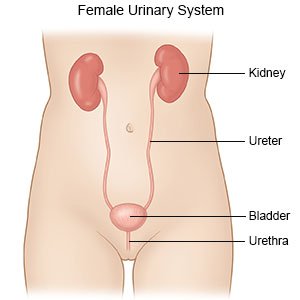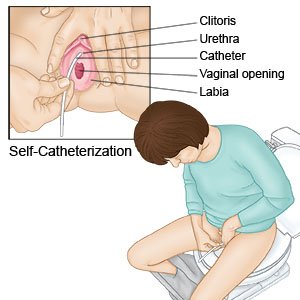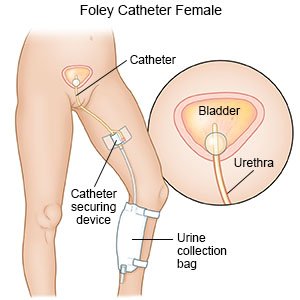Bladder Sling for Women
Medically reviewed by Drugs.com. Last updated on Jun 5, 2024.
AMBULATORY CARE:
What you need to know about a bladder sling procedure:
A bladder sling procedure is surgery to treat urinary incontinence. The sling acts as a hammock to keep your urethra in place and hold it closed when your bladder is full. The urethra is the tube that carries urine from your bladder when you urinate. A sling may be a thin strip of mesh placed under the urethra. The sling may instead be made from a piece of your tissue taken from your abdomen or thigh.
 |
How to prepare for a bladder sling procedure:
- Your surgeon will talk to you about how to prepare. He or she may tell you not to eat or drink anything after midnight on the day of your surgery. Arrange to have someone drive you home when you are discharged.
- Tell your surgeon about all your current medicines. He or she will tell you if you need to stop any medicine for surgery, and when to stop. He or she will tell you which medicines to take or not take on the day of your surgery.
- Tell your surgeon about any allergies you have, including to anesthesia or medicines. You may be given an antibiotic to help prevent a bacterial infection.
What will happen during surgery:
The way your surgeon does the surgery depends on the type of sling you need. Your surgeon may make one or more incisions in your abdomen or vagina. The sling will be placed through an incision. Your surgeon will explain which sling is being used and how he or she will place it into your body. The following is general information about this type of surgery:
- You may be given general anesthesia to keep you asleep and free from pain during surgery. You may instead be given local anesthesia to numb the surgery area. With local anesthesia, you may still feel pressure or pushing during surgery, but you should not feel pain. A small incision will be made in your vagina to insert the sling. You may also have small incisions in your lower abdomen or thigh.
- The sling will be placed under your urethra and around the area where your urethra and bladder meet. One end of the sling will be on each side of your urethra. The ends of the sling may be stitched to your abdominal wall. Small pins or screws may instead be placed in your pelvic bone to hold the sling in place. Your surgeon will check for correct placement of the sling.
- Any small incisions will be closed with stitches or medical glue. A bandage with antibiotic medicine may be put inside your vagina to help prevent infection.
What to expect after a bladder sling procedure:
- Medicines may be given to prevent or treat pain or a bacterial infection.
- You may have vaginal bleeding or discharge for up to a week after your surgery. Use sanitary pads. Do not use tampons.
- You may have some pelvic discomfort after your surgery.
- You may find it hard to urinate or it may feel different than it did before surgery. You may urinate more slowly than you did before surgery. You may need to use a catheter to empty your bladder a few times a day until your function returns. You may have a Foley catheter for a short period of time to drain your urine.
- You will need to avoid any activity that can strain your surgery area. This includes heavy lifting, strenuous exercise, or straining for a bowel movement.
Risks of a bladder sling procedure:
You may bleed more than expected or develop an infection. The sling may break down. You may need another procedure to fix it. You may develop long-term pain. Your bladder or other pelvic organs may be damaged during the procedure. You will need surgery to repair any damage. You may have trouble urinating, or you may still leak urine. You may develop a need to urinate urgently or more often than before surgery. You also may have pain during or after sex. You may develop a blood clot in your limb. This may become life-threatening.
Call your local emergency number (911 in the US) if:
- You have sudden trouble breathing.
Seek care immediately if:
- Your leg feels warm, tender, and painful. It may look swollen and red.
- Your bleeding gets worse.
- You have yellow or foul-smelling discharge from your vagina.
- You cannot urinate, or you are urinating less than what is normal for you.
- You feel confused.
Call your doctor or surgeon if:
- You have a fever.
- You do not feel like you are able to empty your bladder completely when you urinate.
- You have pain or pressure in your vagina.
- You feel the need to urinate suddenly or often.
- You have burning or stinging when you urinate.
- You have blood in your urine.
- Your skin is itchy, swollen, or you have a rash.
- You have questions or concerns about your condition or care.
Medicines:
You may need any of the following:
- Prescription pain medicine may be given. Ask your healthcare provider how to take this medicine safely. Some prescription pain medicines contain acetaminophen. Do not take other medicines that contain acetaminophen without talking to your healthcare provider. Too much acetaminophen may cause liver damage. Prescription pain medicine may cause constipation. Ask your healthcare provider how to prevent or treat constipation.
- Antibiotics help prevent or treat a bacterial infection.
- Take your medicine as directed. Contact your healthcare provider if you think your medicine is not helping or if you have side effects. Tell your provider if you are allergic to any medicine. Keep a list of the medicines, vitamins, and herbs you take. Include the amounts, and when and why you take them. Bring the list or the pill bottles to follow-up visits. Carry your medicine list with you in case of an emergency.
Self-catheterization:
You may need to put a catheter into your bladder after you urinate to empty any remaining urine. A catheter is a small rubber tube used to drain urine. Healthcare providers will teach you how to put the catheter in safely. This may be needed until you are completely emptying your bladder when you urinate.
 |
Foley catheter:
You may have a Foley catheter for a short period of time. The Foley is a tube put into your bladder to drain urine into a bag. Keep the bag below your waist. This will prevent urine from flowing back into your bladder and causing an infection or other problems. Keep the tube free of kinks so the urine will drain properly. Do not pull on the catheter. This can cause pain and bleeding, and may cause the catheter to come out.
 |
Activity:
Do not lift heavy objects for 6 weeks after your procedure. Do not have sex for 4 to 6 weeks. Do not use a tampon for 4 weeks. Ask your healthcare provider when you can return to work or your usual activities.
Do pelvic muscle exercises:
These are also called Kegel exercises. These exercises help strengthen your pelvic muscles and help prevent urine leakage. Tighten the muscles of your pelvis and hold them tight for 5 seconds. Then relax for 5 seconds. Gradually work up to tightening them for 10 seconds and relaxing for 10 seconds. Do this 3 times each day.
Keep a record:
Keep a record of when you urinate and if you leak any urine. Write down what you were doing when you leaked urine, such as coughing or sneezing. Bring the record to your follow-up visits.
Prevent constipation:
Drink liquids as directed. You may need to drink more water than usual to soften your bowel movements. Eat a variety of healthy foods, especially fruits, vegetables, and other foods high in fiber. You may need to use an over-the-counter bowel movement softener.
 |
Follow up with your doctor or surgeon as directed:
You may need a test to check how much urine remains in your bladder after you urinate. This will help show how the sling is working. Write down your questions so you remember to ask them during your visits.
© Copyright Merative 2024 Information is for End User's use only and may not be sold, redistributed or otherwise used for commercial purposes.
The above information is an educational aid only. It is not intended as medical advice for individual conditions or treatments. Talk to your doctor, nurse or pharmacist before following any medical regimen to see if it is safe and effective for you.
Further information
Always consult your healthcare provider to ensure the information displayed on this page applies to your personal circumstances.
